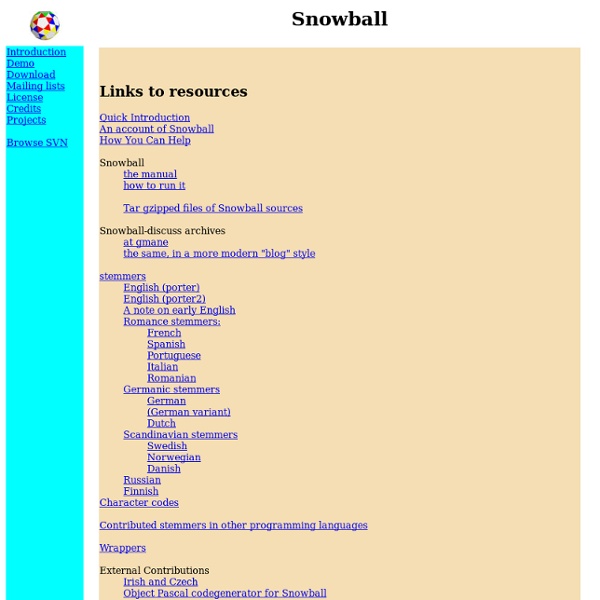



Download MaltParser is distributed under this open source license. Latest release Note: Since the release of MaltParser 1.7 the name of the packages are maltparser-<version>.tar.gz and maltparser-<version>.zip. Note: The latest release of MaltParser version 1.7.2 cannot use parser models created with version 1.6.1 or previous releases of MaltParser. MaltParser 0.x family releases MaltParser 1.0.0 and later releases constitute a complete reimplementation of MaltParser in Java and are distributed with an open source license. MaltParser 0.x family releases can be found at Stemming Stemming programs are commonly referred to as stemming algorithms or stemmers. Examples[edit] A stemmer for English, for example, should identify the string "cats" (and possibly "catlike", "catty" etc.) as based on the root "cat", and "stemmer", "stemming", "stemmed" as based on "stem". A stemming algorithm reduces the words "fishing", "fished", and "fisher" to the root word, "fish". History[edit] The first published stemmer was written by Julie Beth Lovins in 1968.[1] This paper was remarkable for its early date and had great influence on later work in this area. A later stemmer was written by Martin Porter and was published in the July 1980 issue of the journal Program. Many implementations of the Porter stemming algorithm were written and freely distributed; however, many of these implementations contained subtle flaws. Algorithms[edit] There are several types of stemming algorithms which differ in respect to performance and accuracy and how certain stemming obstacles are overcome.
Open Xerox: Parse text Share: Xerox Incremental Parser Home > Services > Xerox Incremental Parser > Forms > Parse text Xerox Incremental Parser An advanced incremental text parser for English, French and German with XML output (other languages are also supported, contact us) /Services/XIPParser Parse text The Xerox Incremental Parser will analyse the text input (parse) and provide a text description of the extracted entities and their relations. <Options> can take the following values: "-text" if the input is in text format"-tr -f -text" if the input is in text format and to display dependencies "-t -text" if the input is in text format, the output displays the syntactic tree"-f -xml -text" if the input is in text format, the output is in xml"-xmltext 2" if the input is in xml The last option must be "-text" or "-xmltext depth" For more details about other option values see the XIP Reference Guide documentation or options. Local file path: Result Comments User Name: Enter the 2 words: Write a comment ...
Stemming and lemmatization Next: Faster postings list intersection Up: Determining the vocabulary of Previous: Other languages. Contents Index For grammatical reasons, documents are going to use different forms of a word, such as organize, organizes, and organizing. Additionally, there are families of derivationally related words with similar meanings, such as democracy, democratic, and democratization. The goal of both stemming and lemmatization is to reduce inflectional forms and sometimes derivationally related forms of a word to a common base form. am, are, is be car, cars, car's, cars' car The result of this mapping of text will be something like: the boy's cars are different colors the boy car be differ color However, the two words differ in their flavor. The most common algorithm for stemming English, and one that has repeatedly been shown to be empirically very effective, is Porter's algorithm (Porter, 1980). would map replacement to replac, but not cement to c. to oper. Exercises.
jointparser The jointparser is a parser that jointly annotates syntax and semantics. It performs syntactic parsing, shallow semantic parsing and predicate identification. And it is one of the few parsers that simultaneously learns and annotates syntax and semantics. We extended the Eisner algorithm to annotate semantics by assigning semantic links at each dependency scoring step. For efficiency reasons, some syntax-based features used in the semantic classifier are pre-computed. The system description can be found at: Xavier Lluís and Stefan Bott and Lluís Màrquez A Second-Order Joint Eisner Model for Syntactic and Semantic Dependency Parsing In Proceedings of the CoNLL-2009 Shared Task bib. Software used in this demo: FreeLing POS tagger and lemmatizer whatswrong dependency structure visualizer To try this parser just write a sentence:
Integration Services Transformations SQL Server Integration Services transformations are the components in the data flow of a package that aggregate, merge, distribute, and modify data. Transformations can also perform lookup operations and generate sample datasets. This section describes the transformations that Integration Services includes and explains how they work. The following transformations perform business intelligence operations such as cleaning data, mining text, and running data mining prediction queries. The following transformations update column values and create new columns. The following transformations create new rowsets. The following transformations distribute rows to different outputs, create copies of the transformation inputs, join multiple inputs into one output, and perform lookup operations. Integration Services includes the following transformations to add audit information and count rows.
Usage - tt4j - How to use TT4J - TreeTagger for Java The main class is TreeTaggerWrapper. One TreeTagger process will be created and maintained for each instance of this class. The associated process will be terminated and restarted automatically if the model is changed (setModel(String)). During analysis, two threads are used to communicate with the TreeTagger. Analyzing tokens For easy integration into application, this class takes any object containing token information and either uses its toString() method or a TokenAdapter set using setAdapter(TokenAdapter) to extract the actual token. Getting probabilities Since version 1.1.0, TT4J allows to fetch probabilities from TreeTagger. Note: This feature requires a TreeTagger binary newer than 2012-04-25. Locating executables and models Per default the TreeTagger executable is searched for in the directories indicated by the system property treetagger.home, the environment variables TREETAGGER_HOME and TAGDIR in this order.
YouTube Trends